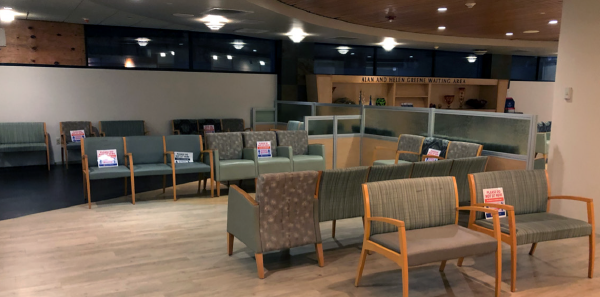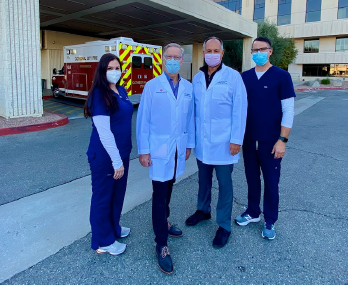
The leadership team in the Tennity Emergency Department at Eisenhower Health in Rancho Mirage, California, was struggling with their operations. The Tennity ED was seeing more than 83,000 patients annually in its 55-bed emergency department. The Coachella Valley is a popular retirement/resort destination, and the patient makeup at Tennity is heavily geriatric (56 percent). The admission rate varies by season between 25 and 30 percent, and boarding was problematic during peak times. Eisenhower Health is home to a new emergency medicine residency, so the teaching mission is important and another factor in ED operational efficiency.
Explore This Issue
ACEP Now: Vol 40 – No 02 – February 2021Prior to the COVID-19 pandemic, the department was struggling to see patients in a timely manner, with door-to-clinician times at 70 minutes and total walkaway rates (left before treatment complete, or LBTC) topping out at 9.2 percent. The ED and hospital leaders wanted to reengineer their emergency department to better meet the demands of the community, and they began working on that before the pandemic. Rather than stopping the redesign when the pandemic hit, they soldiered throughout the following six months to accomplish the task. Marty Massiello, chief operating officer, and Ann Mostofi, chief nursing officer, provided the ED leadership team with process-improvement professionals and the right resources to support the project. Everyone stepped up.
The leadership team—medical director Euthym Kontaxis, MD; department chairman and operations director David Romness, MD; ED nursing director Tasha Anderson, RN; assistant nursing director Joshua Hickman, RN; nurse practitioner Ervin Xhufka, RN; process-improvement lead Joseph Torres; and Epic data analyst Andres Beltran—brought together representatives from all stakeholder groups to redesign the emergency department. The team ambitiously developed a sophisticated flow model with complex patient streaming built upon a physician in triage (PIT) platform (see Figure 1). Because low-acuity volumes were dropping, the team found that populating a traditional fast track was hit-or-miss. The department decided on a rapid treatment unit (RTU) model, which is a flexible unit that merges fast track and “mid track” functions and responds to the Emergency Severity Index (ESI) distribution that presents to the emergency department on any given day.
Table 1: Tennity ED Metrics Before and After
| Before COVID | After COVID | After Improvement | |
|---|---|---|---|
| Patients per day | 229 | 153 | 179 |
| Door to doctor (minutes) | 70 | 86 | 14 |
| Left before treatment complete | 0.092 | 0.075 | 0.019 |
| Left without being seen | 0.024 | 0.064 | 0.007 |
| Length of stay (minutes) | 264 | 332 | 225 |
The New Flow

Tennity ED leadership team (from left): ED nursing director Tasha Anderson, RN; department chairman and operations director David Romness, MD; medical director Euthym Kontaxis, MD; and assistant nursing director Joshua Hickman, RN.
All patients are seen by a rapid assessment nurse and a registration clerk, where a quick (less than three minute) intake process begins. Registration creates a patient identity, and the assessment nurse does a “quick-look ESI” with a chief complaint, allergies, and pulse oximetry readings. This is enough information for the first round of patient sorting. Patients needing immediate bedding are sent to the acute care areas. Patients who can remain vertical and are deemed nonacute pass through the PIT. The PIT experience is rapid: The physician does a quick, focused history and physical; places orders; and writes a very abbreviated note. The ED tech draws labs and/or obtains an ECG, and the patient is escorted to the area selected by the physician as the most appropriate zone.
PIT patient streaming is based on acuity as designated by ESI and anticipated length of stay, which the physician is best at determining. The entire PIT process takes less than six minutes per patient. Scripting and information cards are used to explain the new process to the patient. The patient may go to one of the following areas: fast track; mid track (both located in the RTU); acute care zones 1, 2, or 3; or a psychiatric bed. The icing on the cake for the whole flow model is the institution of flow nurses called “patient flow coordinators” who constantly monitor flow and load level as well as identify bottlenecks in the department. The Tennity ED leadership team has also been creative in implementing a COVID-19 hot zone as case counts rise and fall. They created a separate negative pressure “COVID suspect” assessment area and a COVID-19 hot zone with appropriate isolation rooms and personal protective equipment for higher-acuity patients in the acute care part of the emergency department.
Education and training for implementing the new model included:
Pages: 1 2 3 | Single Page







No Responses to “ED’s Shift To Physician-in-Triage Enabled Fast Assessment, Treatment”